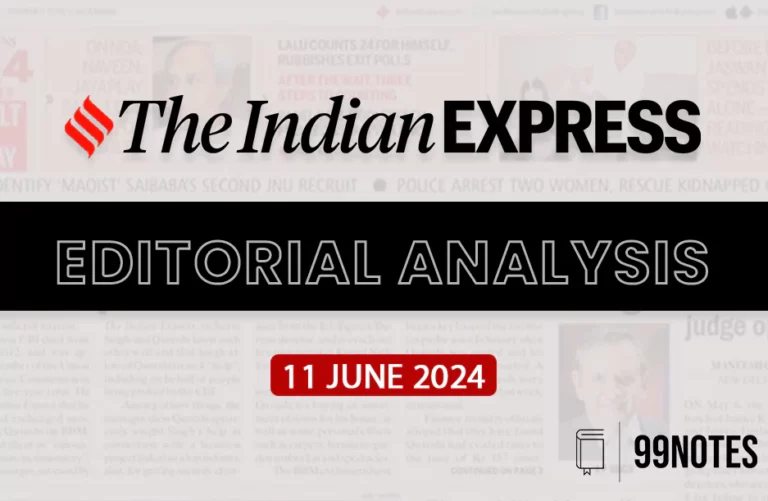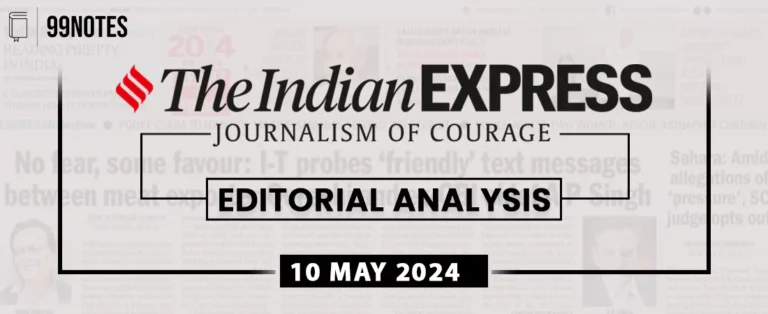18 January 2025 : Indian Express Editorial Analysis
1. Incentives, not resources
(Source – Indian Express, Section – The Editorial Page – Page No. – 14)
| Context |
|
Analysis of the news:
Post-Pandemic Macroeconomic Recovery in India
- India’s macroeconomic policy has traditionally prioritized structural reforms and development to drive growth, and the post-pandemic period was no exception.
- Effective policy measures helped smooth external shocks and induced a robust recovery.
- However, growth remains cyclical, and the pace of government spending—critical for sustaining momentum—has slowed in recent months.
- The Centre’s capital expenditure was at 46.2% of the target by November 2023, significantly lower than 58.5% the previous year. States also underutilized their allocated capital expenditure.
- This slowdown highlights the need for the government to meet spending targets while balancing fiscal consolidation to reduce India’s combined fiscal deficit of over 7% of GDP, one of the highest globally.
- Achieving falling debt and deficit ratios is essential to reduce interest rate spreads and create fiscal space.
Investment Efficiency and Stimulating Private Sector Growth
- The quality of government spending, particularly public investment, has a direct impact on economic stimulus.
- Despite maintaining revenue expenditure, reduced public investment has contributed to the economic slowdown. Increasing the share of public investment and ensuring efficient spending can release resources for growth.
- Incentivizing states to meet capital expenditure targets through conditionalities has proven effective and should continue.
- Private corporate investment, however, remains tepid despite tax cuts. Private sector fixed capital formation peaked in 2007-08 and has since averaged only 21.5% of GDP from 2015-21, indicating that resources alone are insufficient to boost investment.
- Policies like a tax on non-business income paired with investment tax credits could stimulate private investment. Additionally, job-creation incentives could foster economic activity and consumption growth.
Utilizing Domestic and Foreign Savings for Investment
- India faces constraints in utilizing domestic and foreign savings effectively for investment.
- While foreign inflows often exceed the current account deficit, it is investment demand—not the availability of resources—that limits growth.
- Domestic savings, particularly private corporate savings, have increased, yet their deployment for productive investments remains low.
- Policymakers must focus on addressing structural barriers to investment rather than resource allocation alone.
Consumption Patterns and Income Distribution
- Consumption growth has rebounded, with official and independent surveys reporting 8-9% growth in 2023.
- Recovery has also reached lower-income groups, contrary to concerns about a K-shaped recovery.
- However, income distribution remains uneven. While a substantial Indian middle class exists, it is concentrated in the lower-income brackets.
- For instance, only 5% of the population earned over ₹8 lakh annually in 2023, limiting the demand for premium products.
- Corporate strategies focusing solely on higher-income groups have resulted in slower demand growth.
- Tax reforms, such as income tax cuts for lower slabs, could boost disposable income and spending, particularly among price-sensitive groups.
- Simplification of tax laws, removal of loopholes, and expanding the tax base are crucial for sustained economic growth and equitable income distribution.
Agricultural Reforms and Food Supply Management
- India’s evolving consumption patterns reflect declining shares of cereals and rising demand for diversified and processed foods.
- However, vegetable supply chains remain disorganized, leading to price volatility.
- State-level agricultural marketing reforms, such as enabling private markets and direct farm gate sales, are progressing but require broader implementation.
- Research shows farmers who diversify production earn higher profits, underscoring the importance of easing sales of diverse produce.
- Strengthening food supply chains, improving coordination between the Centre and states, and promoting diversification in agriculture are essential for controlling food price spikes and ensuring better farmer incomes.
- The Centre’s efforts to simplify archaic regulations must also extend to local governments to reduce bottlenecks faced by businesses.
The Role of Interest Rates and Budget Priorities
- Cost-push inflation has moderated, creating room for lower real interest rates.
- Reduced interest rates could spur demand, particularly among India’s younger population looking to buy homes and durable goods.
- Policymakers must also recognize the need for conservative macroeconomic policies to counter global uncertainties.
- However, India’s pandemic response demonstrated the economy’s resilience, highlighting the potential of strategic policy interventions to mitigate external shocks.
Conclusion
- Budget priorities should focus on improving production conditions, fostering well-designed incentives to stimulate investment, and addressing structural constraints.
- Merely allocating resources will not suffice; policies must be targeted, innovative, and responsive to evolving economic needs.
| Challenges in Achieving Economic Recovery |
| Supply Chain Disruptions The pandemic caused significant disruptions in global supply chains. Many businesses faced delays in receiving raw materials and shipping finished products. This led to increased costs and reduced availability of goods. Some key points include:
Labor Market Challenges The labor market has also faced serious issues. Many workers lost their jobs during the pandemic, and finding new employment has been tough. Some challenges include:
Inflationary Pressures Inflation has become a major concern as economies try to recover. Prices for goods and services have risen, affecting consumers and businesses alike. Important factors include:
|
| Practice Question: Discuss the challenges and steps required to balance fiscal consolidation, investment efficiency, and inclusive growth in India’s post-pandemic economic recovery. (150 Words /10 marks) |
For more such UPSC related Current Affairs, Check Out: 17 January 2025 : Indian Express Editorial Analysis




